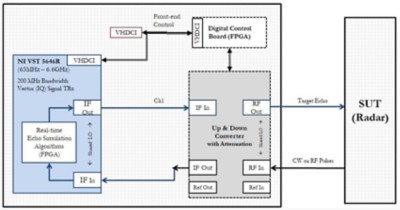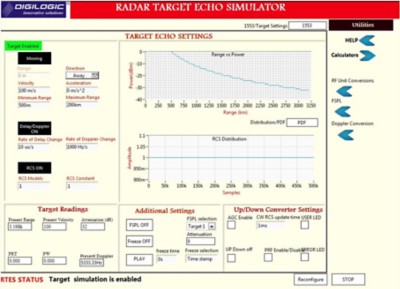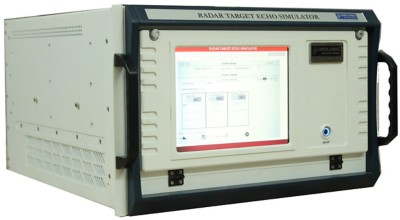DSPL Builds a Portable, Scalable Radar Target Echo Simulator for Radar Test and Evaluation
J. Tejeswar, Digilogic Systems Pvt. Ltd. (DSPL)
"By choosing PXI Express COTS hardware and the LabVIEW software platform for this solution, we successfully designed and developed a complicated simulation system within six months. To address requirements in Ku/Ka bands, we just need to upgrade the RF up/downconverter used with the PXI VST module. "
- J. Tejeswar, Digilogic Systems Pvt. Ltd. (DSPL)
The Challenge:
Developing today’s sophisticated radar systems requires advanced simulation and measurement to evaluate performance. To achieve this, we required a way to perform more realistic testing with RF signals representing field environment conditions like multiple targets, clutters, and Radar Cross Section (RCS) models.
The Solution:
We used the scalable architecture of PXI Express hardware and powerful LabVIEW software to design and develop our portable and scalable Radar Target Echo Simulator in six months. This solution delivers more realistic field signals within a laboratory environment for the evaluation of radars.
Author(s):
J. Tejeswar - Digilogic Systems Pvt. Ltd. (DSPL)
S. Srikanth - Digilogic Systems Pvt. Ltd. (DSPL)
About DSPL
Digilogic Systems Pvt. Ltd. (DSPL), located in Secunderabad, India, is a systems integrator with expertise in DAQ systems, automated test equipment, RF simulators, and signal processing algorithms based on NI technology. DSPL offers turnkey systems and solutions in the aerospace and defense industries. An NI Partner with a specialty in RF and communication, DSPL is also certified with ISO 9001:2015 and CSIA and has won multiple awards from NI. Within DSPL, our team designs and develops RF simulators and signal processing algorithms.
Description
The need for real-time simulation systems and tools to test radar systems is increasing in parallel with developments in radar technology. We must justify the algorithms used in radar signal processor units (RSPUs) under real environmental conditions prior to the actual deployment of the radars. Real environmental tests are expensive and it is almost impossible to repeat the experiments under the same conditions. Therefore, we needed to develop a system that simulates the environment in which radar signals travel and the targets the radar is trying to detect.
System Design
These kinds of simulations require a lot of real-time signal processing, so we developed this simulator system using the NI PXI Vector Signal Transceiver (VST) on a PXIe-1085 chassis. The PXI VST module offers us the required resources for digital signal processing in real time on an FPGA.
Our solution includes the following hardware components:
- PXIe-1085 chassis to house PXI Express modules and route data between the modules
- PXI VST with onboard FPGA to receive the downconverted radar signal, incorporate all the desired echo characteristics, and retransmit as RF output containing the target echoes to the upconverter
- AIT MIL-STD-1553B interface module to communicate and get feedback from radar being tested
- DSPL X-band RF Up/Downconverter for VST to upconvert and downconvert the signals in X-band to a signal compatible with VST
Application Flow
The overall application flow for our portable Radar Target Echo Simulator is:
1. Acquire the radar signal in X-band with DSPL X-band RF Up/Downconverter for VST using the downconverter section
2. Downconvert the X-band signals to an IF frequency compatible with VST
3. Downconvert the IF signals to baseband IQ data using VST
4. Measure the signal characteristics like center frequency, power, pulse width, and pulse repetition time for user analysis
5. Incorporate the desired echo characteristics into the acquired signal
6. Upconvert the IQ data with echo characteristics to IF frequency and generate using VST as input to the upconverter section of RF Up/Downconverter for VST
7. Upconvert the IF signal with target echoes and retransmit as X-band RF signal output

This complete process starting from receiving the RF signal to retransmitting the echo RF signal works with a timing latency of 2.4 microseconds (minimum time delay between receiving and retransmitting RF signal is 400 meters) and resolution that we can achieve in our system in approximately 1.2 meters.
Radar, which is the system under test (SUT), will start transmitting RF signals once powered on. The RF signals in the X-band interface between SUT and the portable Radar Target Echo Simulator using the DSPL X-band RF Up/Downconverter for VST. To set the parameters in the SUT as well as receive feedback from the SUT, we used the MIL-STD-1553B communication interface. This interface is provided in the portable Radar Target Echo Simulator using a CompactPCI-based module.
Once the SUT starts transmitting RF signals, the downconverter section in the RF Up/Downconverter for VST receives these signals. As mentioned earlier, we downconvert this signal to an IF signal to go as input to the PXI VST. The digital I/O lines in the VST control the RF center frequency of the RF downconverter. Using LabVIEW FPGA, we programmed the VST to incorporate the desired echo characteristics on the received signal. The radar echo parameters that we can configure include range, Doppler, RCS, and noise jamming. We can then retransmit the modified signal through the RF output port of the VST and provide the signal as input to the X-band upconverter section, which upconverts it to the desired X-band RF frequency. The digital I/O lines of the VST control both the output frequency and the output power of the signal. As we set the echo parameters, we can determine if the SUT is detecting them correctly by comparing the settings defined in the portable Radar Target Echo Simulator scenario and feedback received on the MIL-STD-1553B interface.


We gained three advantages by choosing NI’s technology for this simulation system.
- Availability of RF Transceiver With Onboard FPGA—These kinds of systems require one channel for receiver and one channel for transmitter, so the availability of both on the VST module significantly reduced the physical size of the solution. Without this module, we would have had to use multiple stand-alone instruments that are bulky in size and more expensive. The PXI VST module helped us make our solution a portable one.
- Power of LabVIEW FPGA Tool—Using FPGA is a major part of this system. If we had to program the FPGA on VHDL/Verilog, it would have taken a much longer time for the scale of application software we were addressing. We used LabVIEW FPGA for a seamless integration of our software algorithms with the FPGA present in the PXI VST module, which accelerated our software development efforts.
- High Data Streaming Technology of PXI Express—We took advantage of the peer-to-peer streaming capability of the PXIe-1085 chassis to handle the signal processing between the FPGAs present in the VST and PXIe-7975R FlexRIO FPGA modules.
Features of the Radar Target Echo Simulator:
- Based on PXI Express commercial off-the-shelf (COTS) hardware
- Easy-to-use software GUIs for radar echo simulation functionalities
- Range, Doppler, RCS, noise jamming
- Scalable, upgradable hardware and software platform
- Portable benchtop system
- Includes RF signal recording for offline simulations

Conclusion
By choosing PXI Express COTS hardware and the LabVIEW software platform for this solution, we successfully designed and developed a complicated simulation system within six months. To address requirements in Ku/Ka bands, we just need to upgrade the RF up/downconverter used with the VST module. We upgraded the same system to include features like RGPO and VGPO (ECM features) in one month since application software is written using LabVIEW and LabVIEW FPGA. Therefore, we feel we can scale the system to address any future add-ons easily without significant R&D effort.
Author Information:
J. Tejeswar
Digilogic Systems Pvt. Ltd. (DSPL)
Plot No. 1-8-303/48/30, 1st & 2nd Floor, Behind Ashoka My Home Chambers, Penderghast Road, Secunderabad
Telangana 500003
India
Tel: +91-40-27819935, 27819936
Fax: +91-40-2781993
info@digilogicsystems.com
An NI Partner is a business entity independent from NI and has no agency or joint-venture relationship and does not form part of any business associations with NI.
